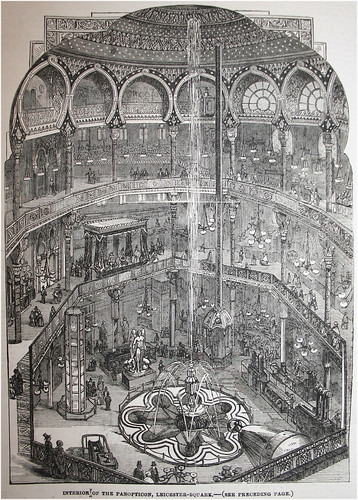In the days prior to the development of the mass-market cinema, one of the most popular forms of morally suitable entertainment was to visit a site of ephemeral entertainments in the cities. These “fun fairs” would promote themselves as displays of the wonders of modern science and the industrial revolution – but it is clear that they were there to entertain, and the displays were more often of the weird and bizarre than of the serious.
In the centre of London, there were several such venues, and although they have all vanished, the building which housed one still remains at the top of Regent’s Street – now occupied by the University of Westminster. The original building is now due to be restored to its later life – as the UK’s first ever cinema.
One other site was in Leicester Square at the beginnings of its life as the entertainment heart of the capital city, and I have transcribed a description of its opening below.
The site was proud to remind visitors of its scientific heritage – being on the site of John Hunter’s house, where he experimented with surgery and started his huge collection of anatomy specimens. Many of those are still on display in the wonderous Huntarian Museum near Holborn.
In addition, the site boasted of one of the UK’s first elevators – known as “ascending rooms”, and relied on an artesian well for its fountain – just as Trafalgar Square had at the time.
Although the news article below wishes the venture well, it actually closed after just two years and was converted into a Music Hall known as the Alhambra Theatre, which thrived until World War One. The building was sadly demolished in 1936 and is now the site of the Odeon Leicester Square.
THE PANOPTICON IN LEICESTER-SQUARE
This new “Institution for Scientific Exhibitions, and for Promoting Discoveries in Arts and Manufacturers,” was opened for private inspection yesterday, and on Thursday, and to-day is opened to the public. The building occupies a large space on the centre of the east side of Leicester-square, for many years a great focus of metropolitan exhibitors. The Panopticon, however, belongs to a higher class than the majority of the sights previous located in the Square. Of the exterior of the edifice, we have a view in the ILLUSTRATED LONDON NEWS for Jan. 31 1852.
The style of the architecture is reputed Saracenic; and its minarets and horse-shoe arches are of that period of art; but its escutcheons, which are prominent features of the elevation, represent the most important branches of the arts and sciences., in the arms of their professors; in addition to the Royal arms, and the bearings of the Panopticon itself, with the motto, “Mente et manu” The site has, moreover olden scientific repute; for, upon this spot, John Hunter collected his valuable museum, and in one of the adjoining houses was temporarily located “the National Repository” some four-and-twenty years since – this being the first “Polytechnic” Exhibition in the metropolis.
Having passed through the vestibule, which is pleasingly decorated with encaustic tiles and English alabaster, next is the internal porch, “strictly ornate Saracenis,” and then we reach the Rotunda here Engraved. The centre is occupied with a magnificent fountain, and throughout the circle are two galleries, with ornate fronts, stalls, and richly decorated ceilings. The great central dome is radiant with gold and colour, and through the glass crown a circle of small stars, and a series of semicircular windows, the vast apartment is lighted. This room is about 97 feet in diameter, and the same in height, and the total cubical contents of the Gall and its recesses are about 500,000 feet; in addition to the space occupied by the boxes and the organ-gallery. At night it will be lighted by lamps of design in keeping with the character of the decorations. The fountain throws up a centre jet to the height of the dome, and eight minor jets, each 40 feet, converging to the centre; the water being obtained from an Artesian well 346 feet deep. The fountain is worked by a powerful pneumatic apparatus, aided by a steam-engine.
In the lower gallery is a Photographic Room, which may be reached by the staircases, or by an ascending carriage up a shaft. Around the Rotunda are the Laboratory and adjoining the apparatus-rooms; and descending, you reach the circular railway, engine-room, &c. North and south are Lecture-rooms. The ventilation and warming are by “Gurney’s Warming Battery,” which is described in the “Handbook” sold in the establishment. To the same source we refer the reader for the details of the apparatus to be exhibited here to illustrate diving; turning and planning, drilling and boring, the combustion of steel; aurora-borealis and thunder, pin making and needle-making, and gas cookery, freezing mercury; the liquefaction and solidification of carbonic acid; ballooning under water; galvanism, magnetism, and the electric light; and a large collection of machinery, models, &c. In the first gallery is a “Royal stand” sumptuously fitted with scarlet and gold.
The east side of the Rotunda is filled from the first gallery with an organ, by Hill and Co, who state that it exceeds in tone and compass every other organ in the metropolis, and the organs of York and Birmingham. It consists of 4 manuals, each from C C to A in alto; and a pedal organ from C C C to F, 30 notes. It contains 60 stops, 7 couplers, 10 composition pedals, 1 crescendo pedal and 40,004 pipes. There are seven bellows, of different pressures of wind, worked by steam.
The scheme of the Panopticon promises much for the popular spread of science in its application to the arts and manufactures; to which are to be added the attractions of painting, sculpture, and music; and we shall be happy to record its success.







